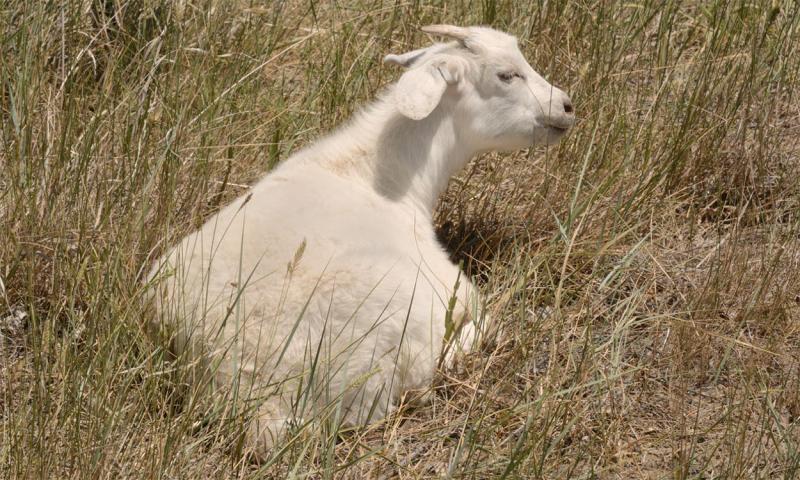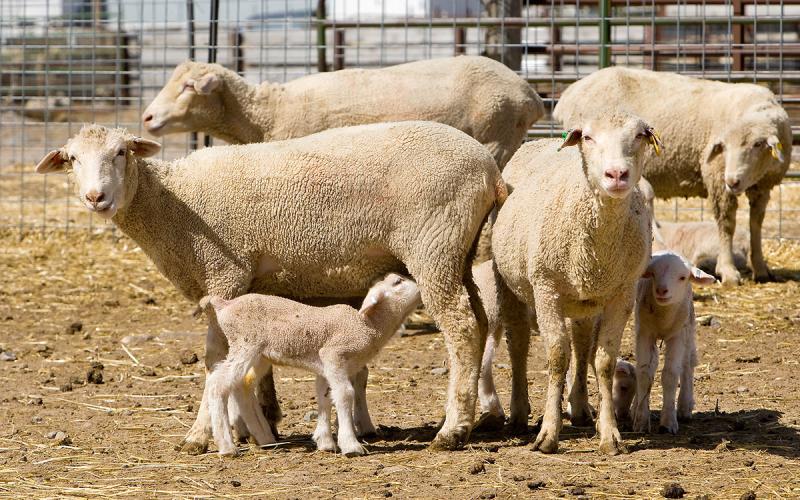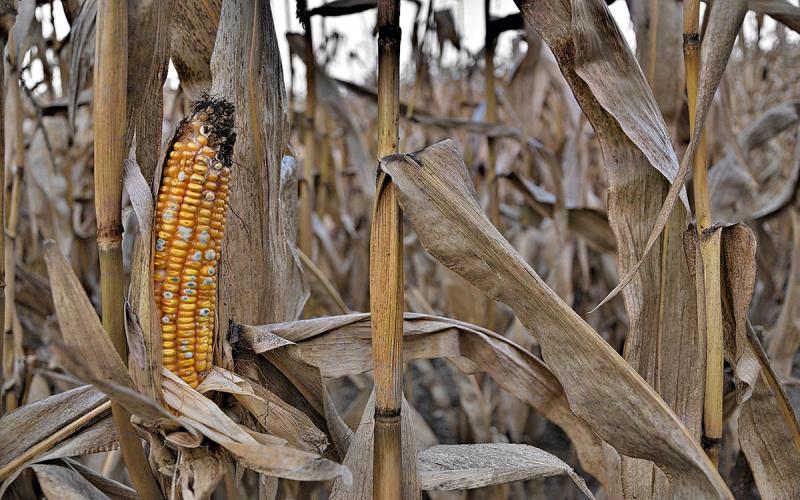
Written with contributions by Heidi Carroll, former SDSU Extension Livestock Stewardship Field Specialist & Beef Quality Assurance Coordinator, and Kelly Froehlich, former Assistant Professor & SDSU Extension Sheep and Goat Specialist.
The Upper Midwest provides periods of extreme heat during summer and shorter periods of heat stress potential during spring and fall. Are your sheep and goats cool enough in their environment? Heat stress affects sheep and goat performance by decreasing dry matter intake, while increasing the need for water. This, in return, has a direct impact on weight gain and milk production. Although sheep and goats are more heat-tolerant than other ruminants (e.g. cows), it is important to understand and identify when they may be experiencing stress.
Understanding Heat Stress
Several factors contribute to whether a sheep or goat will experience heat stress, including breed, relative humidity, temperature, wind speed and solar radiation. The comfort zone of a fully fleeced sheep is about 10–90 degrees Fahrenheit; this is where heat produced is the same as heat lost. Temperature comfort zone is less defined in goats, but it is generally accepted that they are better adapted to hot conditions. However, temperature is only part of the equation, with humidity having a huge impact on whether an animal will feel cool or heat stressed. Therefore, temperature humidity index (THI) is the best measure of livestock environmental stress (Table 1). Specifically for sheep and goats, heat stress is experienced when THI is at moderate (82 to <84 degrees Fahrenheit), severe (84 to < 86 degrees Fahrenheit) and extreme (≥86 degrees Fahrenheit) levels. This means for South Dakota’s moderately humid summers that heat stress may be experience when the temperature starts rising above 80 degrees Fahrenheit. Specific for South Dakota, South Dakota State University (SDSU) Extension has a Livestock Stress Tool that can also indicate environmental stresses.
|
|
|
||||||||||||||||
|---|---|---|---|---|---|---|---|---|---|---|---|---|---|---|---|---|---|
| 20 | 25 | 30 | 35 | 40 | 45 | 50 | 55 | 60 | 65 | 70 | 75 | 80 | 85 | 90 | 95 | ||
|
|
54 | 53 | 53 | 53 | 53 | 52 | 52 | 52 | 52 | 52 | 51 | 51 | 51 | 51 | 50 | 50 | |
|
|
56 | 56 | 56 | 56 | 56 | 56 | 56 | 56 | 56 | 56 | 55 | 55 | 55 | 55 | 55 | 55 | |
|
|
59 | 59 | 59 | 59 | 59 | 59 | 59 | 60 | 60 | 60 | 60 | 60 | 60 | 60 | 60 | 60 | |
|
|
62 | 62 | 62 | 62 | 63 | 63 | 63 | 63 | 63 | 64 | 64 | 64 | 64 | 64 | 65 | 65 | |
|
|
65 | 65 | 65 | 66 | 66 | 66 | 67 | 67 | 67 | 68 | 68 | 68 | 69 | 69 | 69 | 70 | |
|
|
68 | 68 | 68 | 69 | 69 | 70 | 70 | 71 | 71 | 72 | 72 | 73 | 73 | 74 | 74 | 75 | |
|
|
70 | 71 | 72 | 72 | 73 | 73 | 74 | 75 | 75 | 76 | 76 | 77 | 78 | 78 | 79 | 79 | |
|
|
73 | 74 | 75 | 75 | 76 | 77 | 78 | 78 | 79 | 80 | 81 | 81 | 82a | 83a | 84b | 84b | |
|
|
76 | 77 | 78 | 79 | 79 | 80 | 81 | 82a | 83a | 84b | 85b | 86c | 86c | 87c | 88c | 89c | |
|
|
79 | 80 | 81 | 82 | 83 | 84b | 85b | 86b | 87c | 88c | 89c | 90c | 91c | 92c | 93c | 94c | |
|
|
82a | 83a | 84b | 85b | 86b | 87c | 88c | 90c | 91c | 92c | 93c | 94c | 95c | 97c | 98c | 99c | |
THI Levels: aModerate (yellow) 82 to < 84˚F; bSevere (orange) 84 to < 86˚F; cExtreme (red) >86˚F

A heat-stressed sheep or goat will sweat, open-mouth pant and will experience increases in respiration rate (breaths/minute) and rectal temperature. This creates a cascading effect on biological functions, including depressed feed intake, feed efficiency and even affecting water, protein, energy and mineral balances, which leads to overall reduced performance. Small ruminants can withstand short periods of heat stress if followed by cooler temperatures, such as nighttime temperatures below a THI of 81. However, alleviating periods of heat stress can help improve performance.
Alleviating Heat Stress
Although THI is used as the primary heat stress measure, other environmental factors, such as solar radiation and air movement, can affect how a sheep or goat handle heat stress.
- When possible, provide shade during the day to alleviate heat stress, especially in animals with darker coats.
- Minimize or avoid unnecessary animal work during peak heat times (10 a.m. to 4:00p.m.).
- Ensure adequate ventilation and air movement to animals housed indoors.
One of the best practices for alleviating heat stress is providing plenty of clean, cool water.
- Provide one to three pounds of water per-pound dry matter.
- Check water quality.
Although it is always recommended to provide water, it is especially important to encourage its intake during heat stress. When encouraging water intake, ask yourself, “Would you drink this water?” If the answer is no, why is that? Maybe a little extra time is needed to clean the stock tank, or there may be off flavors. In South Dakota, high amounts of dissolved solids, alkalinity, nitrates and blue-green algae can affect quality, which can make water unappetizing or have further biological complications. More on water quality can be read in the article, How Important Is Water Quality to Livestock?. Especially in drought years, it is essential to routinely check your water quality. SDSU Extension provides on-site quick water tests at regional and some extension county offices. This summer, do not let poor water quality affect your small ruminant’s ability to effectively handle heat stress.
Heat stress can adversely affect the performance of sheep and goats. Recognizing and alleviating heat stress by providing shade plenty of air movement, avoiding unnecessary animal work and encouraging consumption of fresh clean water will help minimize production losses.
References
- Marai, I. F. M., A. A. El-Darawany, A. Fadiel, and M. A. M. Abdel-Hafez. 2007. Physiological traits as affected by heat stress in sheep—A review. Small Ruminant Research 71(1):1-12.
- Sarangi, S. 2018. Adaptability of goats to heat stress : A review. Pharma Innovation 7(4):1114-1126.
- Silanikove, N. 2000. Effects of heat stress on the welfare of extensively managed domestic ruminants. Livestock Production Science 67(1):1-18.
- Srikandakumar, A., E. H. Johnson, and O. Mahgoub. 2003. Effect of heat stress on respiratory rate, rectal temperature and blood chemistry in Omani and Australian Merino sheep. Small Ruminant Research 49(2):193-198.


